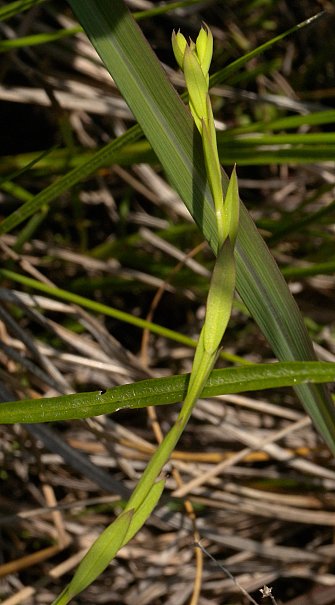
The blooming period occurs from mid-summer to early autumn, lasting about 1 month. Individual flowers are diurnal and short-lived. Afterwards, the flowers are replaced by small seed capsules about 2 mm. across; these capsules are subgloboid in shape and a little shorter than the sepals. At maturity, the capsules split open into 10 segments to release numerous tiny seeds. These seeds are small enough to be blown about by the wind. The root system consists of a small crown of shallow fibrous roots.
Cultivation: The preference is full sun, moist to mesic conditions, and soil containing calcareous sand, rocky material, or heavy clay-loam. This plant doesn't tolerated much competition from other ground vegetation, especially other broad-leaved plants (dicots). Depending on the local ecotype, the winter-hardiness and environmental preferences of this plant can vary significantly.
 Range
& Habitat:
Stiff Yellow Flax is
occasional along Lake Michigan in NE Illinois, uncommon in the southern
half of Illinois, and rare or absent elsewhere within the state (see Distribution
Map).
It is native to Illinois and widely distributed in
the eastern United States. Illinois lies along the NW range-limit of
this species. Habitats include rocky upland woodlands, rocky glades,
upland savannas, moist to dry sand prairies, borders of sandy ponds,
moist sand flats (pannes) along Lake Michigan, borders of interdunal
swales
along Lake Michigan, and abandoned sand or gravel pits that have been
excavated close to the surface of ground water. Stiff Yellow Flax is
usually found in high quality natural areas.
Range
& Habitat:
Stiff Yellow Flax is
occasional along Lake Michigan in NE Illinois, uncommon in the southern
half of Illinois, and rare or absent elsewhere within the state (see Distribution
Map).
It is native to Illinois and widely distributed in
the eastern United States. Illinois lies along the NW range-limit of
this species. Habitats include rocky upland woodlands, rocky glades,
upland savannas, moist to dry sand prairies, borders of sandy ponds,
moist sand flats (pannes) along Lake Michigan, borders of interdunal
swales
along Lake Michigan, and abandoned sand or gravel pits that have been
excavated close to the surface of ground water. Stiff Yellow Flax is
usually found in high quality natural areas.Faunal Associations: Very little is known about the floral-faunal relationships of Stiff Yellow Flax (Linum medium texanum) and other native yellow-flowered flaxes (Linum spp.). The flowers of a closely related species (Linum sulcatum) were visited by bees and beetles (Smith et al., 2012; MacRae, 1991). The caterpillars of a polyphagous moth, Xestia c-nigrum (Lesser Black-letter Dart), use flax species as host plants (Wikipedia, 2015). During the winter, a small songbird, Ammodramus henslowii (Henslow's Sparrow), eats the seeds of Stiff Yellow Flax to a minor extent in Louisiana (DiMiceli, 2006). It is possible that other granivorous songbirds eat the seeds or seed capsules of this plant during autumn migration in Illinois.
Photographic Location: A moist sand flat (panne) near Lake Michigan in NE Illinois.
Comments: This is one of several yellow-flowered flax species (Linum spp.) that are native to Illinois and surrounding states. As a group, these species are not well-known and they are rarely cultivated. Their flowers are smaller in size and less showy than the often-cultivated Linum perenne lewisii (Wild Blue Flax). The typical variety of Stiff Yellow Flax, Linum medium medium, is found primarily in Ontario and it is quite rare. It differs from Linum medium texanum by its wider leaves (3.5–6 mm. across), and its seed capsules divide into 5 segments, rather than 10 segments. In regards to their chromosomes, Linum medium texanum is diploid, while Linum medium medium is tetraploid. The other species of yellow-flowered flax are very similar to Stiff Yellow Flax in appearance. One species, Linum sulcatum (Grooved Yellow Flax), is a herbaceous annual that has pairs of dark glands at the bases of its leaves, its leaves are more slender (linear-elliptic) in shape, and its stems sometimes branch underneath their inflorescences. Another species, Linum striatum (Ridged Yellow Flax), differs from Stiff Yellow Flax by having mostly opposite leaves, rather than alternate leaves. A third species, Linum virginianum (Woodland Yellow Flax), lacks stalked glands on its inner sepals, and the decurrent ridges along each stem that extend from its leaves are weaker and shorter.